|
Euthymius
Euthymius the Great (377 – 20 January 473) was an abbot in Palestine (region), Palestine. He is venerated in both Roman Catholic and Eastern Orthodox Churches. Euthymius' ''Hagiography, vita'' was written by Cyril of Skythopolis, who describes him as the founder of several monasteries in the Judaean desert, while remaining a solitary monk in the tradition of Egyptian monasticism. He nevertheless played a decisive role in helping the decisions of the Council of Chalcedon (451) prevail in Jerusalem, in spite of the majority of the monks in the region opposing it. Life Euthymius was born in Melitene in Lesser Armenia, in a pious family of noble birth. According to Christian tradition, his parents, Paul and Dionysia, had prayed for a son at the church of Saint Polyeuctus in Melitene. When the child was born, they named him ''Euthymius'', meaning "good cheer". Euthymius was educated by Bishop Otreius of Melitene, who afterwards Ordination#Christianity, ordained him and placed hi ... [...More Info...] [...Related Items...] OR: [Wikipedia] [Google] [Baidu] |
Euthymius The Great
Euthymius the Great (377 – 20 January 473) was an abbot in Palestine. He is venerated in both Roman Catholic and Eastern Orthodox Churches. Euthymius' ''vita'' was written by Cyril of Skythopolis, who describes him as the founder of several monasteries in the Judaean desert, while remaining a solitary monk in the tradition of Egyptian monasticism. He nevertheless played a decisive role in helping the decisions of the Council of Chalcedon (451) prevail in Jerusalem, in spite of the majority of the monks in the region opposing it. Life Euthymius was born in Melitene in Lesser Armenia, in a pious family of noble birth. According to Christian tradition, his parents, Paul and Dionysia, had prayed for a son at the church of Saint Polyeuctus in Melitene. When the child was born, they named him ''Euthymius'', meaning "good cheer". Euthymius was educated by Bishop Otreius of Melitene, who afterwards ordained him and placed him in charge of all the monasteries in the Diocese of Me ... [...More Info...] [...Related Items...] OR: [Wikipedia] [Google] [Baidu] |
Theoctistus Of Palestine
Venerable Theoctistus of Palestine (also Theoktistos) was an associate of Euthymius the Great. He was an ascetic who lived in a nearby cell at the Pharan lavra. Ascetic life About five years after Euthymius arrived, they went into the desert for Great Lent, and found in a wadi a large cave where they remained praying in solitude for some time. Eventually shepherds from Bethany discovered them, and people from the area began to visit seeking spiritual guidance and bringing food. The monks then built a church. When other monks came seeking instruction, Euthymius and Theoctistus built a lavra over the cave church. Theoctistus became hegumen of the monastery. Euthymius is credited with establishing several monasteries, including that of Theoctistus. Death and commemoration Theoctistus died at an advanced age in 451 and is commemorated on 3 September. References Further reading *{{cite book , title=The Lives of the Saints, url=https://archive.org/details/TheLivesOfTheSaintsV ... [...More Info...] [...Related Items...] OR: [Wikipedia] [Google] [Baidu] |
Cyril Of Skythopolis
Cyril of Scythopolis ( gr, Κύριλλος ὁ Σκυθοπολίτης, Kyrillos ho Skythopolitēs; – ), also known as Cyrillus Scythopolitanus, was a Christian monk, priest and Greek-language hagiographer or historian of monastic life in Palestine in the early years of Christianity (6th century AD). Life Cyril was born in Scythopolis, in the province of Palaestina Secunda, sometime around 525. His father John, a lawyer, supervised his early religious education. Shortly after 532 he became an '' anagnostes'' (lector), and became a monk in 543. Very soon thereafter he went to Jerusalem and spent some months at a hermit community (''lavra'') near the Jordan River, before entering the monastery of Euthymius the Great at Jericho in 544. He remained there until 555, when he was one of the orthodox monks sent to replace those expelled for Origenism at the New Lavra of Saint Sabas (today in ruins at Bir el-Wa'ar near Tekoah). Two years later he moved to the Great Lavra of Saint Sa ... [...More Info...] [...Related Items...] OR: [Wikipedia] [Google] [Baidu] |
Wadi Og
Nahal Og or Wadi Og ( he, נחל אוג), or Wadi al-Muqallek, also spelled Wadi Muqallik ( ar, وادي مكلك) is a winterbourne stream on the West Bank that drains the eastern slopes of the Mount of Olives range east of Jerusalem and runs for 30 km till the Dead Sea.Nahal Og at ''Afek Family Travels'' It is the northernmost of the streams that flow from the into the Dead Sea.Nahal Og (Og Stream) at ''Israel Traveler'' Name The |
Judaean Desert
The Judaean Desert or Judean Desert ( he, מִדְבַּר יְהוּדָה, Midbar Yehuda}, both ''Desert of Judah'' or ''Judaean Desert''; ar, صحراء يهودا, Sahraa' Yahuda) is a desert in Palestine and Israel that lies east of Jerusalem and descends to the Dead Sea. Under the name El-Bariyah, it has been nominated to the Tentative List of World Heritage Sites in the State of Palestine, particularly for its monastic ruins. Etymology The term he, מִדְבַּר יְהוּדָה, , Desert of Judaea originates in the Hebrew Bible, and it is mentioned in Judges and Psalms. It is sometimes known as he2, יְשִׁימוֹן ''Yeshimon'', meaning ''desert'' or ''wildland'', or yet ''Wilderness of Judah'' or ''Wilderness of Judaea'', among others. Geography The Judaean Desert lies east of Jerusalem and descends to the Dead Sea. The Judaean Desert stretches from the northeastern Negev to the east of Beit El, and is marked by natural terraces with escarpments. I ... [...More Info...] [...Related Items...] OR: [Wikipedia] [Google] [Baidu] |
Lavra
A lavra or laura ( el, Λαύρα; Cyrillic: Ла́вра) is a type of monastery consisting of a cluster of cells or caves for hermits, with a church and sometimes a refectory at the center. It is erected within the Orthodox and other Eastern Christian traditions. The term is also used by some Roman Catholic communities. The term in Greek initially meant a narrow lane or an alley in a city.. History Byzantine laura/lavra From the fifth century the Greek term ''laura'' could refer specifically to the semi-eremitical monastic settlements of the Judaean Desert, where lauras were very numerous. The first lauras of Palestine were founded by Chariton the Confessor (born 3rd century, died ca. 350): the Laura of Pharan (now Wadi Qelt) northeast of Jerusalem, the Laura of Douka on the Mount of Temptation west of Jericho, and Souka Laura or Old Laura in the area of Tuqu' in Wadi Khureitun. Saint Euthymius the Great (377–473) founded one of the early lauras in fifth-century Palestine. The ... [...More Info...] [...Related Items...] OR: [Wikipedia] [Google] [Baidu] |
Saint Polyeuctus
Saint Polyeuctus (also Polyeuctes, Polyeuktos, Greek: Πολύευκτος) of Melitene (died 10 January 259) was an ancient Roman saint. Christian tradition states that he was a wealthy Roman army officer who was the first martyr in Melitene, Armenia, under Valerian. Symeon Metaphrastes writes that, moved by the zeal of his friend Saint Nearchus, Polyeuctus had openly converted to Christianity. "Enflamed with zeal, St Polyeuctus went to the city square, and tore up the edict of Decius which required everyone to worship idols. A few moments later, he met a procession carrying twelve idols through the streets of the city. He dashed the idols to the ground and trampled them underfoot." He was tortured by the authorities and ignored the tears and protestations of his wife Paulina, his children, and his father-in-law. He was beheaded. Veneration He was buried at Melitene, and a church was dedicated to him there. Christian tradition states that the parents of Euthymius ... [...More Info...] [...Related Items...] OR: [Wikipedia] [Google] [Baidu] |
Chariton The Confessor
Chariton the Confessor (Greek: Χαρίτων; mid-3rd century, Iconium, Asia Minor – c. 350, Judaean desert) was a Christian saint. His remembrance day is September 28. Life Sources We know about his ''vita'' from the 6th-century "Life of Chariton", written by an anonymous monk, which holds elements supported by modern archaeological excavations. Early life Chariton was a native of Iconium in the Byzantine province of Lycaonia. Under the reign of Emperor Aurelian (270-275) he was tortured and came close to become a martyr during a persecution against Christians. Released from prison after Aurelian's death, he regretted not having died as a martyr. Pharan near Jerusalem After his release in 275, during a pilgrimage to Jerusalem and other holy places, Chariton was abducted by bandits and brought to a cave in the Pharan Valley (upper Wadi Qelt). The traditional account states that his abductors died by drinking wine that was poisoned by a snake. Chariton decided to remain a he ... [...More Info...] [...Related Items...] OR: [Wikipedia] [Google] [Baidu] |
Saint
In religious belief, a saint is a person who is recognized as having an exceptional degree of Q-D-Š, holiness, likeness, or closeness to God. However, the use of the term ''saint'' depends on the context and Christian denomination, denomination. In Catholic Church, Catholic, Eastern Orthodox Church, Eastern Orthodox, Anglican Communion, Anglican, Oriental Orthodox, and Lutheranism, Lutheran doctrine, all of their faithful deceased in Heaven are considered to be saints, but some are considered worthy of greater honor or emulation. Official ecclesiastical recognition, and consequently a public cult of veneration, is conferred on some denominational saints through the process of canonization in the Catholic Church or glorification in the Eastern Orthodox Church after their approval. While the English word ''saint'' originated in Christianity, History of religion, historians of religion tend to use the appellation "in a more general way to refer to the state of special holiness t ... [...More Info...] [...Related Items...] OR: [Wikipedia] [Google] [Baidu] |
Ordination
Ordination is the process by which individuals are Consecration, consecrated, that is, set apart and elevated from the laity class to the clergy, who are thus then authorization, authorized (usually by the religious denomination, denominational hierarchy composed of other clergy) to perform various religious Ritual, rites and ceremonies. The process and ceremonies of ordination vary by religion and Religious denomination, denomination. One who is in preparation for, or who is undergoing the process of ordination is sometimes called an ordinand. The liturgy used at an ordination is sometimes referred to as an ordination. Christianity Roman Catholic, Orthodox, Lutheran and Anglican churches In Roman Catholicism and Orthodoxy, ordination is one of the seven sacraments, variously called holy orders or ''Christian laying on of hands, cheirotonia'' ("Laying on of Hands"). Apostolic succession is considered an essential and necessary concept for ordination in the Catholic, Orthodo ... [...More Info...] [...Related Items...] OR: [Wikipedia] [Google] [Baidu] |
Diocese
In Ecclesiastical polity, church governance, a diocese or bishopric is the ecclesiastical district under the jurisdiction of a bishop. History In the later organization of the Roman Empire, the increasingly subdivided Roman province, provinces were administratively associated in a larger unit, the Roman diocese, diocese (Latin ''dioecesis'', from the Greek language, Greek term διοίκησις, meaning "administration"). Christianity was given legal status in 313 with the Edict of Milan. Churches began to organize themselves into Roman diocese, dioceses based on the Roman diocese, civil dioceses, not on the larger regional imperial districts. These dioceses were often smaller than the Roman province, provinces. Christianity was declared the Empire's State church of the Roman Empire, official religion by Theodosius I in 380. Constantine the Great, Constantine I in 318 gave litigants the right to have court cases transferred from the civil courts to the bishops. This situ ... [...More Info...] [...Related Items...] OR: [Wikipedia] [Google] [Baidu] |
Jerusalem
Jerusalem (; he, יְרוּשָׁלַיִם ; ar, القُدس ) (combining the Biblical and common usage Arabic names); grc, Ἱερουσαλήμ/Ἰεροσόλυμα, Hierousalḗm/Hierosóluma; hy, Երուսաղեմ, Erusałēm. is a city in Western Asia. Situated on a plateau in the Judaean Mountains between the Mediterranean Sea, Mediterranean and the Dead Sea, it is one of the List of oldest continuously inhabited cities, oldest cities in the world and is considered to be a holy city for the three major Abrahamic religions: Judaism, Christianity, and Islam. Both Israelis and Palestinians claim Jerusalem as their Capital city, capital, as Israel maintains its primary governmental institutions there and the State of Palestine ultimately foresees it as its seat of power. Because of this dispute, Status of Jerusalem, neither claim is widely recognized internationally. Throughout History of Jerusalem, its long history, Jerusalem has been destroyed at least twice, Sie ... [...More Info...] [...Related Items...] OR: [Wikipedia] [Google] [Baidu] |




.jpg)




